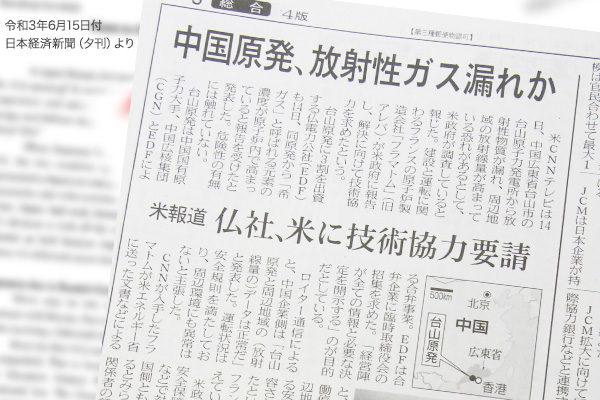Radioactive substances have recently leaked from the Unit 1 reactor of the Taishan nuclear power station in the southern Chinese province of Guangdong. The reactor is a 1.65 million-kilowatt cutting-edge European pressurized water reactor that started operation in 2018. China delayed information disclosure regarding this incident, indicating its tendency to hide unfavorable facts.
Information disclosure came two days after a media report
The incident came to light on June 14 as CNN reported that French nuclear plant maker Framatome (formerly Areva) that exported the reactor to China told the U.S. government of an “imminent radiological threat.”
On June 16, two days after the report, China’s Ministry of Ecology and Environment that regulates nuclear facilities there announced that fuel rods were broken to cause a rise in the concentration of radioactive substances in coolant. It admitted that less than 0.01% of all fuel rods for the reactor, or about five fuel rods, were broken. The reactor core has 265 fuel assemblies and each assembly comprises 241 fuel rods. The total number of fuel rods comes to 63,865 of which 0.01% amounts to some five rods. But this must be checked with the reactor’s lid opened before a precise conclusion.
This time, information has been disclosed gradually following the CNN report. In Japan and Western countries, any radiation increase is usually published to mass media as soon as it is detected. No such prompt information disclosure is seen in China, which has been criticized for its cover-up habitude on the occasion of novel coronavirus outbreak.
Leaked noble gases include xenon and krypton. If the leak is caused by a coolant loss accident or a reactor cooling pump failure, it must be quickly reported to the International Atomic Energy Agency. But the United States and the IAEA denied such accident based on information from Framatome. The U.S. government said the leak was not at any critical level. Framatome’s parent company Electricite de France said the leak represented a controlled release.
A sudden rise in the concentration of noble gases could indicate damage to cladding tubes of fuel rods. A foreign material might have hung on a fuel lattice to cause vibration to bore a hole in the cladding tube. Leaked noble gases would be mixed into reactor-cooling water and sent to a gas decay tank in an auxiliary building. In one month, they would be decayed to one-thousandth of the original concentration and become ready to be released from an exhaust stack. Framatome’s warning of an imminent threat may mean that the tank was filled up. But no such detail has been published.
Put a brake on China’s winning run
China now operates 47 nuclear reactors, boasting of the world’s third largest nuclear power generation capacity at 48.75 million kilowatts following the U.S. and France. Planning to build 200 reactors, China has been negotiating nuclear reactor export deals with many foreign countries. It has invested in nuclear plant construction projects in Britain and France. Its Belt and Road Initiative to expand its scope of influence through infrastructure investment features cheap nuclear and coal power plant exports. China now accounts for 53% of global coal power plant exports, defeating Japan.
China’s winning run to become the world’s largest energy power should be braked by the international community from the viewpoint of safety first for nuclear power plants. Any abnormality regarding nuclear power plant in operation should be promptly disclosed and followed by a temporary non-operation for checkups.
Tadashi Narabayashi is a specially appointed professor at the Tokyo Institute of Technology and a director at the Japan Institute for National Fundamentals.


